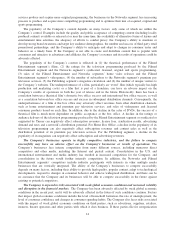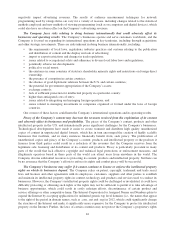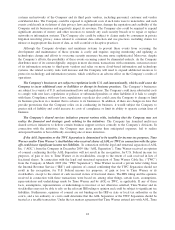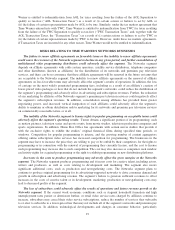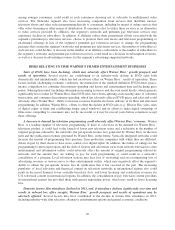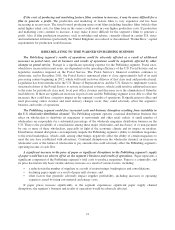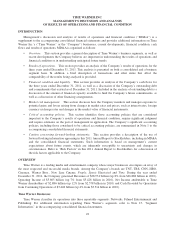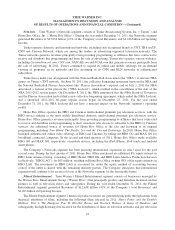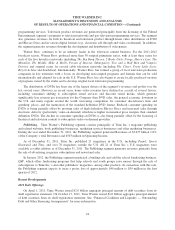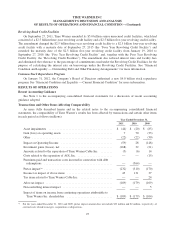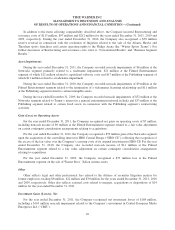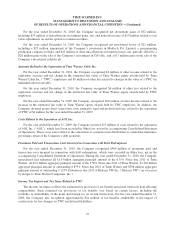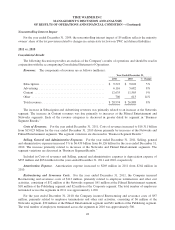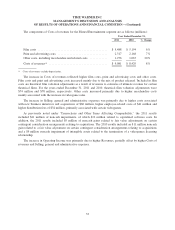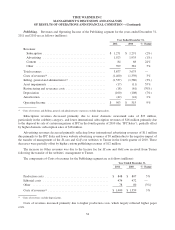Time Magazine 2011 Annual Report Download - page 38
Download and view the complete annual report
Please find page 38 of the 2011 Time Magazine annual report below. You can navigate through the pages in the report by either clicking on the pages listed below, or by using the keyword search tool below to find specific information within the annual report.TIME WARNER INC.
MANAGEMENT’S DISCUSSION AND ANALYSIS
OF RESULTS OF OPERATIONS AND FINANCIAL CONDITION – (Continued)
programming services. Television product revenues are generated principally from the licensing of the Filmed
Entertainment segment’s programs to television networks and pay television programming services. The segment
also generates revenues for both its theatrical and television product through home video distribution on DVD
and Blu-ray Discs and in various digital formats (e.g., electronic sell through and video-on-demand). In addition,
the segment generates revenues through the development and distribution of videogames.
Warner Bros. continues to be an industry leader in the television content business. For the 2011-2012
broadcast season, Warner Bros. produced more than 30 scripted primetime series, with at least three series for
each of the five broadcast networks (including The Big Bang Theory,2 Broke Girls,Fringe,Harry’s Law,The
Mentalist,The Middle,Mike & Molly,Person of Interest,Suburgatory,Two and a Half Men and Vampire
Diaries) and original series for several cable television networks (including The Closer,Pretty Little Liars,
Rizzoli & Isles and Southland). Internationally, Warner Bros. has formed a group of local television production
companies in key territories with a focus on developing non-scripted programs and formats that can be sold
internationally and adapted for sale in the U.S. Warner Bros. has also begun to create locally produced versions
of programs owned by the studio and to develop original local television programming.
The distribution of DVDs has been one of the largest drivers of the segment’s revenues and profits over the
last several years. However, in recent years, home video revenues have declined as a result of several factors,
including consumers shifting to subscription rental services and discount rental kiosks, which generate
significantly less revenue per transaction for the Company than DVD sales, the general economic downturn in
the U.S. and many regions around the world, increasing competition for consumer discretionary time and
spending, piracy, and the maturation of the standard definition DVD format. Reduced consumer spending on
DVDs is being partially offset by growing sales of high definition Blu-ray Discs and increased sales through
electronic delivery (particularly video-on-demand) which have higher incremental gross margins than standard
definition DVDs. The decline in consumer spending on DVDs is also being partially offset by the licensing of
theatrical and television content to subscription video-on-demand providers.
Publishing. Time Warner’s Publishing segment consists principally of Time Inc.’s magazine publishing
and related websites, book publishing businesses, marketing services businesses and other marketing businesses.
During the year ended December 31, 2011, the Publishing segment generated Revenues of $3.677 billion (12%
of the Company’s total Revenues) and $563 million in Operating Income.
As of December 31, 2011, Time Inc. published 21 magazines in the U.S., including People,Sports
Illustrated and Time, and over 70 magazines outside the U.S. All 21 of Time Inc.’s U.S. magazines were
available as tablet editions as of December 31, 2011. The Publishing segment generates revenues primarily from
the sale of advertising, magazine subscriptions and newsstand sales.
In January 2012, the Publishing segment negotiated a binding sale and sold the school fundraising business,
QSP, which offers fundraising programs that help schools and youth groups raise money through the sale of
subscriptions to Time Inc.’s and other publishers’ magazines, among other products. In connection with this sale,
the Publishing segment expects to incur a pretax loss of approximately $40 million to $50 million in the first
quarter of 2012.
Recent Developments
2011 Debt Offerings
On April 1, 2011, Time Warner issued $2.0 billion aggregate principal amount of debt securities from its
shelf registration statement. On October 17, 2011, Time Warner issued $1.0 billion aggregate principal amount
of debt securities from its shelf registration statement. See “Financial Condition and Liquidity — Outstanding
Debt and Other Financing Arrangements” for more information.
24


